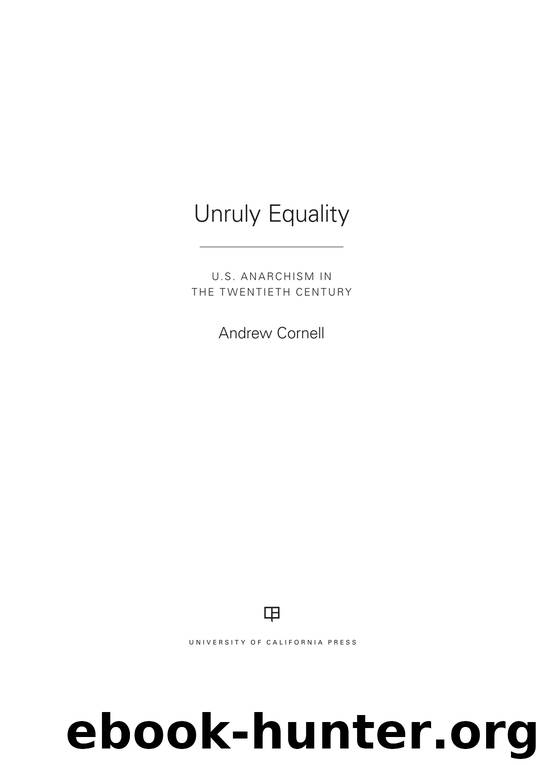Unruly Equality by Andrew Cornell

Author:Andrew Cornell
Language: eng
Format: epub
ISBN: 9780520286733
Publisher: University of California Press
THE ANARCHIST PACIFISTS AND LIBERATION MAGAZINE
As indicated by chapters 5 and 6, the experience of spending years in Civilian Public Service camps and federal penitentiaries for refusal to join the armed services during World War II fundamentally shaped the lives and political commitments of hundreds of men in the postwar years. Those entering prison with commitments to socialism, anarchism, and Gandhian pacifism emerged as nonviolent revolutionaries eager to grow a new movement based on points of unity within the anticommunist Left.
Having successfully overturned racial segregation policies in federal prisons through organized acts of noncompliance, the anarchist pacifists and other nonviolent revolutionaries designated the fight against white supremacy a top priority. The relationships and institutions that the nonviolent revolutionaries developed in the decade after the war became vital to the Black Freedom Movement that fundamentally transformed American life beginning in the 1950s. For more than a decade, the pacifists had bravely experimented with tactics of nonviolent direct action against racial segregation, notably on the 1947 Journey of Reconciliation, and had trained others in these techniques. In 1956 they contributed a platform for debating movement strategy and theory in the form of Liberation magazine.
Shortly before being released in 1945 from his second draft resistance sentence in Lewisburg Penitentiary, David Dellinger had written to Holley Cantine, editor of the anarchist journal Retort, “I have decided that I would like to establish a monthly magazine that will help build up a left-wing pacifist socialist mov’t [sic] and body of thought.”2 A decade later, his own publishing attempts having floundered, Dellinger accepted an invitation from A.J. Muste to co-edit a full-size monthly magazine alongside Bayard Rustin and Roy Finch.3 At the time, Muste served as chair of the Fellowship of Reconciliation (FOR) while Rustin was lauded as an intrepid antiracist organizer and co-founder of the Congress of Racial Equality (CORE). Finch had served time in a Civilian Public Service camp in California, emerged an anarchist, and moved east to throw himself into work with the Committee for Nonviolent Revolution, Peacemakers, and the War Resisters League (WRL). Aided by a larger circle of collaborators, this editorial collective produced a wide-ranging and accessible, yet intellectually rigorous, journal that served as a movement resource for more than two decades. By 1959, circulation reached approximately 2,000 copies per issue.4
Liberation’s debut editorial acknowledged that traditional Left arguments no longer inspired hope and that the world needed fresh vision. The editors encouraged contributors and readers to develop such vision by drawing on four “root traditions.” These included the “Judeo-Christian prophetic tradition, which gave men a vision of human dignity and a reign of righteousness, equality, and brotherhood on earth” and an “American tradition” that “asserts that government rests upon consent, and institutions are made for man, not man for institutions.” In addition to Jefferson and Paine, the editors included Eugene Debs, Randolph Bourne, and the abolitionist movement in this tradition. Third, they looked to “the libertarian, democratic, antiwar, socialist, anarchist and labor movements” that fought for a “class-less and war-less world.”
Download
This site does not store any files on its server. We only index and link to content provided by other sites. Please contact the content providers to delete copyright contents if any and email us, we'll remove relevant links or contents immediately.
| Anarchism | Communism & Socialism |
| Conservatism & Liberalism | Democracy |
| Fascism | Libertarianism |
| Nationalism | Radicalism |
| Utopian |
The Secret History by Donna Tartt(18743)
The Social Justice Warrior Handbook by Lisa De Pasquale(12080)
Thirteen Reasons Why by Jay Asher(8736)
This Is How You Lose Her by Junot Diaz(6700)
Weapons of Math Destruction by Cathy O'Neil(6084)
Zero to One by Peter Thiel(5637)
Beartown by Fredrik Backman(5545)
The Myth of the Strong Leader by Archie Brown(5374)
The Fire Next Time by James Baldwin(5199)
How Democracies Die by Steven Levitsky & Daniel Ziblatt(5096)
Promise Me, Dad by Joe Biden(5036)
Stone's Rules by Roger Stone(4989)
100 Deadly Skills by Clint Emerson(4798)
A Higher Loyalty: Truth, Lies, and Leadership by James Comey(4796)
Rise and Kill First by Ronen Bergman(4658)
Secrecy World by Jake Bernstein(4593)
The David Icke Guide to the Global Conspiracy (and how to end it) by David Icke(4557)
The Farm by Tom Rob Smith(4404)
The Doomsday Machine by Daniel Ellsberg(4375)
